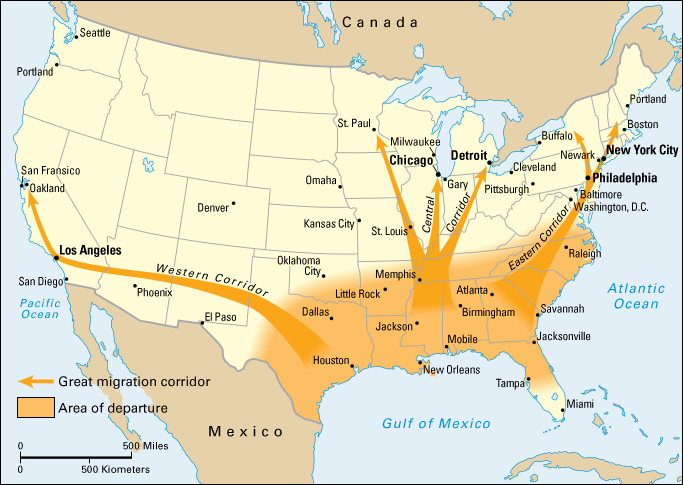Great Migration was the movement of African Americans from rural areas in the southern United States to cities in the northern United States during the 1900’s. The migration took place in two waves. The first wave occurred from about 1915 to 1930. The second wave occurred from about 1940 to 1970. More than 6 million African Americans migrated during these waves. Many moved to escape racism. Racism is the belief that a person’s own race is superior to those of others. Such a belief often leads to racial discrimination—that is, the unequal treatment of people based on race. Many migrants also sought economic opportunities.
Many Black Southerners migrated to the North seeking basic civil and human rights. Racial discrimination was widespread in the South. Many schools, libraries, and other public facilities were racially segregated (separated). Black people were prohibited from using facilities designated for whites only, which were often of better quality.
Other Black people fled the South because of low wages. Many who worked on farms as sharecroppers found it impossible to break a cycle of debt and poverty. Sharecropping is an arrangement in which laborers farmed the land and paid rent in crops to the owner. During World War I (1914-1918), hundreds of thousands of Black Americans migrated from the South to the North. They were attracted by the possibility of securing high-paying jobs in defense plants and other factories. Reduced immigration from Europe, due to the war, had made more such jobs available.
The Black migrants left farms and small rural towns in Alabama, Louisiana, Mississippi, South Carolina, and other Southern states. They settled in such large metropolitan centers as New York City and Philadelphia in the Northeast; Chicago and Detroit in the Midwest; and Los Angeles in the West. Others settled in smaller cities, including Gary, Indiana; Newark, New Jersey; and Oakland, California.

The transition to life in colder climates and crowded cities where housing was scarce and expensive was especially challenging for many Black migrants. Jobs available to African Americans were often the most dangerous and lowest paying. Racial segregation on the streets and in the neighborhoods surrounding places of employment reminded many Black citizens of the legal segregation that they had faced in the South.
Nevertheless, life in the North provided these descendants of enslaved people with economic, political, and social opportunities that were unavailable in the South. As the number of migrants increased, African American businesses, schools, neighborhoods, and places of worship often thrived. Northern cities became important centers of Black life and culture. By the end of the Great Migration, nearly half of all African Americans lived outside the South.
